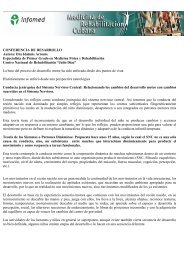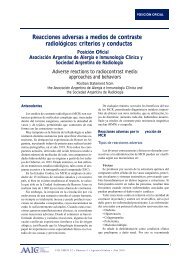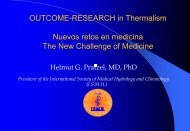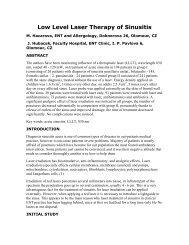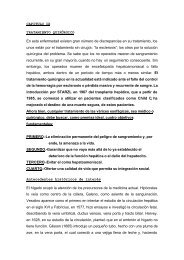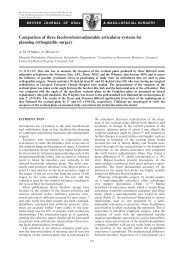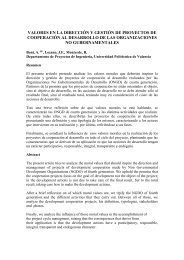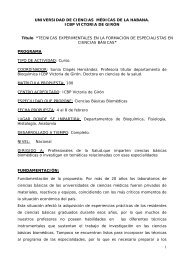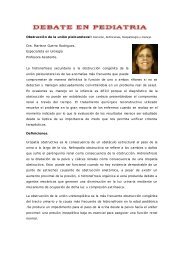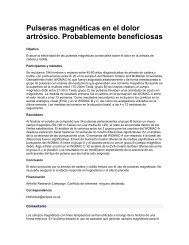pharmacology of medicinal plants and natural products
pharmacology of medicinal plants and natural products
pharmacology of medicinal plants and natural products
You also want an ePaper? Increase the reach of your titles
YUMPU automatically turns print PDFs into web optimized ePapers that Google loves.
S82<br />
S. A. DAHANUKAR et al.,<br />
behaviour. It had no effect on haloperidol induced<br />
catalepsy, thus showing no effect on dopamine mediated<br />
behaviour 7 .<br />
A lot <strong>of</strong> attention has been focused on the effect <strong>of</strong><br />
BR-16A (Mentat), a polyherbal formulation, on learning<br />
<strong>and</strong> memory. It has been shown to augment<br />
acquisition <strong>and</strong> retention <strong>of</strong> learning in normal rats,<br />
as well as in states <strong>of</strong> cognitive deficits induced by<br />
variety <strong>of</strong> insults including pre-natal undernutrition,<br />
post-natal environmental impoverishment, sodium<br />
nitrite hypoxia, aluminium, increasing age <strong>and</strong> electroconvulsive<br />
shock (ECS) induced antero-grade <strong>and</strong><br />
retro-grade amnesia 8-10 . Ramteke,et al, 11 demonstrated<br />
that administration <strong>of</strong> BR-16A to slow learning<br />
rats, improved learning (both speed <strong>and</strong> magnitude)<br />
on the Hebb Williams complex maze as compared<br />
to control. The results indicated that BR-16,<br />
like piracetam, could facilitate learning <strong>and</strong> memory,<br />
<strong>and</strong> could be categorized as a nootropic agent.<br />
Bhardwaj <strong>and</strong> Srivastava 12 have shown that Mentat<br />
(designated by them as CIHP III), significantly improved<br />
the avoidance learning during endurance<br />
performance in rats when tested on the Runimex, a<br />
circular runaway. The number <strong>of</strong> stimuli i.e. electrical<br />
shocks required to induce learning were considerably<br />
reduced in the treated animals.<br />
Trasina, a polyherbal formulation, was found to exert<br />
significant nootropic effect following 21 days therapy<br />
in 2 experimental models <strong>of</strong> Alzheimer’s disease.<br />
These models were induced in rats by either injecting<br />
colchicine (15 µg/rat) intra-cerebroventricularly<br />
(i.c.v.) or lesioning <strong>of</strong> nucleus basalis magnocellularis<br />
by ibotenic acid (10 µg/rat). Trasina improved both<br />
memory <strong>and</strong> levels <strong>of</strong> various cholinergic markers<br />
like acetylcholine concentration, choline acetyl transferase<br />
activity <strong>and</strong> muscarinic cholinergic receptor<br />
binding in frontal cortex <strong>and</strong> hippocampus <strong>of</strong> rat brain.<br />
Thus its nootropic effect may be attributed to correction<br />
<strong>of</strong> cholinergic dysfunction 13 .<br />
Pre-treatment with Memorin (200 mg/day/kg), another<br />
herbal formulation, was found to attenuate electroconvulsive<br />
shock induced retrograde amnesia in rats<br />
when tested for passive avoidance learning paradigms<br />
in a shuttle box 14 .<br />
2.2. Psychoactives<br />
The leaf extract <strong>of</strong> Azadirachta indica (Neem) exhibited<br />
anxiolytic effects comparable to diazepam at low<br />
doses (10-200 mg/kg), when tested in rats. Higher<br />
doses (>400 mg/kg) however, did not show anxiolytic<br />
activity 15 .<br />
Ethanol extract <strong>and</strong> cold aqueous infusion <strong>of</strong> Vitex<br />
leucoxylon (Nirnochi in Tamil) leaf depressed spontaneous<br />
motor activity, antagonised d-amphetamine<br />
induced sterotypy <strong>and</strong> oxotremorine induced tremors<br />
<strong>and</strong> shortened the duration <strong>of</strong> immobility in the<br />
behavioural ‘despair’ test in mice 16 .<br />
Methanolic extract <strong>of</strong> rhizomes <strong>of</strong> Nelumbo nucifera<br />
(Kamal) was found to cause significant reduction in<br />
spontaneous activity, decrease in the exploratory<br />
behavioural pattern by the head dip <strong>and</strong> Y maze tests,<br />
muscle relaxant activity <strong>and</strong> potentiation <strong>of</strong> pentobarbitone<br />
induced sleeping time 17 .<br />
Mitra, et al, 18 have shown that the root powder <strong>of</strong><br />
Panax ginseng did not affect pentobarbitone sleep<br />
time or spontaneous motor activity. Although it potentiated<br />
amphetamine induced increase in motility,<br />
it attenuated the other effects <strong>of</strong> amphetamine, viz.<br />
stereotypy <strong>and</strong> lethality in aggressive mice. Haloperidol<br />
catalepsy was potentiated while the behavioural<br />
responses <strong>of</strong> 5-hydroxytryptophan <strong>and</strong> l-dopa were<br />
both attenuated. It exhibited significant aggressioninhibiting<br />
effect in doses that had no effect on spontaneous<br />
movements. The results have been discussed<br />
on the basis <strong>of</strong> interaction <strong>of</strong> Panax ginseng<br />
with the functioning <strong>of</strong> various neurotransmitters.<br />
All extracts [petroleum ether (PEE), benzene(BE),<br />
chlor<strong>of</strong>orm (CE), acetone (AE) <strong>and</strong> ethanol (EE)] <strong>of</strong><br />
the leaf <strong>of</strong> Abies pindrow Royle (Silver fir) showed<br />
potentiation <strong>of</strong> pentobarbitone sleeping time i.e. CNS<br />
depressant effect. The PEE, BE, CE <strong>and</strong> AE (highest<br />
efficacy) showed significant anti-depressant activity.<br />
On the other h<strong>and</strong>, EE was found to potentiate<br />
immobility, suggesting that this fraction is devoid <strong>of</strong><br />
anti-depressant effect 19 .<br />
Ginkgolic acid conjugates (GAC) (6-alkylsalicylates,<br />
namely n-tridecyl-, n-pentadecyl-, n-heptadecyl-, n-<br />
pentadecenyl- <strong>and</strong> n-heptadecenylsalicylates) isolated<br />
from the leaves <strong>of</strong> Indian Ginkgo biloba Linn., a<br />
PAF antagonist, showed consistent <strong>and</strong> significant<br />
anxiolytic activity. By contrast, EGb 761 <strong>and</strong> Ginkocer,<br />
2 conjugates which are devoid <strong>of</strong> GAC, did not evoke<br />
significant activity. EGb 761 was found to increase<br />
rearing <strong>and</strong> decrease immobility time only in open<br />
field behaviour. This effect may be due to weak antianxiety<br />
activity 20 .




